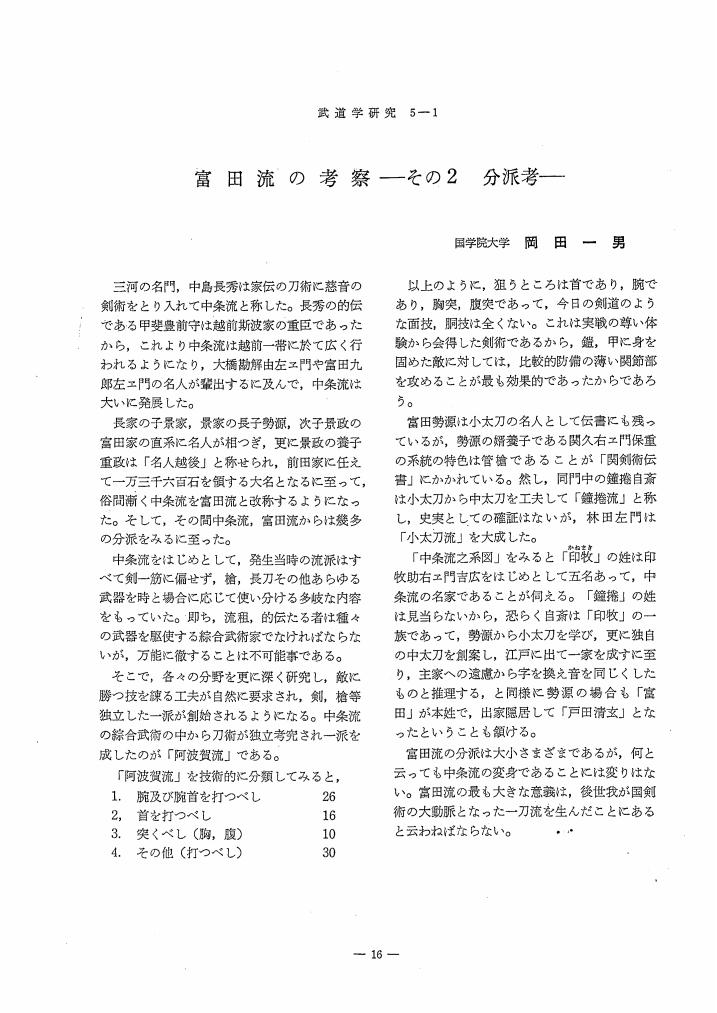1 0 0 0 OA 弓道における弓の握りと射手の手との整合に関する研究
1 0 0 0 OA 弓道の会における外乱負荷の応答について―特に左肩の構え―
1 0 0 0 OA 移動軌跡からみた全日本剣道選手権優勝者宮崎正裕選手の試合特性
- 著者
- 巽 申直 野村 知弘 村山 勤治 小田 佳子 富樫 泰一 服部 恒明
- 出版者
- 日本武道学会
- 雑誌
- 武道学研究 (ISSN:02879700)
- 巻号頁・発行日
- vol.33, no.2, pp.16-23, 2001-01-31 (Released:2012-11-27)
- 参考文献数
- 30
The purpose of this study was to clarify the unique kendo moves used by the All Japan Kendo Champion Masahiro Miyazaki, six-time winner of the all Japan Kendo Championship.Using a direct linear transformation method, traces of the locomotion movement of the kendo players were measured. These measures permitted analysis of the spatial distances between the two competitors (i. e., ma-ai) during their matches. Distribution curves revealed two main types of ma-ai, one which had a higher peak position of sword-guard tangle (i. e., tuba-zeriai), and the other (i. e., issoku-itto-no-maai), which is the distance which enables players to either strike the opponent by taking one step forward and to evade the opponent's striking one step backward. Longitudinal data of 47 matches over 10 years (1990-1999) revealed that:1) The percentage occurrence of Miyazaki's issoku-itto-no-maai was lower relative to tsuba-zeriai, which is typical of all such players.2) The number of Miyazaki's offensive and defensive movements from issoku-itto-no-maai was higher than that of all such players.3) The total times of confrontation in Miyazaki's issoku-itto-no-maai were significantly lower than that of all other players. Namely, his initial offensive movement is much earlier than that of all other players.4) Miyazaki's percentage occurrence of issoku-itto-no-maai tended to increase year by year, coupled with a decrease in the number of offensive and defensive movement from ma-ai.
1 0 0 0 OA 富田流の考察―その2分派考―
- 著者
- 岡田 一男
- 出版者
- 日本武道学会
- 雑誌
- 武道学研究 (ISSN:02879700)
- 巻号頁・発行日
- vol.5, no.1, pp.16-16, 1972-10-30 (Released:2012-11-27)
1 0 0 0 OA 武道の社会学的認識と方法論的自己反省
- 著者
- 根上 優 前田 シン子
- 出版者
- 日本武道学会
- 雑誌
- 武道学研究 (ISSN:02879700)
- 巻号頁・発行日
- vol.22, no.2, pp.141-142, 1989-11-30 (Released:2012-11-27)
1 0 0 0 OA 剣道における足構えと重心動揺の解析
- 著者
- 直原 幹 市川 真澄 山神 眞一 宮本 賢作
- 出版者
- 日本武道学会
- 雑誌
- 武道学研究 (ISSN:02879700)
- 巻号頁・発行日
- vol.30, no.1, pp.14-21, 1997-08-31 (Released:2012-11-27)
- 参考文献数
- 41
The location of the stance during the standard position (Chudan-no-kamae) in Kendo measured from skilled Kendo players (n=28) were divided in the two types, high grade type (=HG) and middle grade type (=MG), according to the trained career (=Dan-i and playing career) of them. The length, width and left foot angle made from vertical line estimated from the location of the stance were compared between HG and MG. The differences of equilibrium between HG and MG were studied in student Kendo players (n=10). The parameters of equilibrium determined by analyzing the center of the foot pressure were the displacement of the body sway and the body sway area. These parameters were compared between HG and MG. The length of the stance (cm/Height) was shorter significantly (p< 0.05) in HG (=0.12±0.03)than in MG (=0.15±0.05). In the width and left foot angle of the stance, there was no difference between HG and MG, respectively. The displacement of the body sway was shorter significantly (p< 0.01) in HG than in MG. As the total period kept standing, mean value of the displacement in HG (=716.6mm) was 14% shorter than in MG (=830.6mm). In the body sway area, there was no difference between HG (=28.9± 13.1cm2) and MG (=30.9 ± 17.0cm2). These results suggest that the equilibrium in Kendo posture correlate closely with the length of stance. In the present paper, correlation between biomechanical properties of the different stance types in Kendo players and skill levels of them are also discussed.
1 0 0 0 OA 幕末剣術の変質過程に関する一考察
- 著者
- 榎本 鐘司
- 出版者
- 日本武道学会
- 雑誌
- 武道学研究 (ISSN:02879700)
- 巻号頁・発行日
- vol.11, no.2, pp.91-92, 1978-11-30 (Released:2012-11-27)
- 参考文献数
- 6
1 0 0 0 OA 幕末剣術の変質過程に関する研究―幕末諸藩における竹刀打込試合剣術の伝播について―
- 著者
- 榎本 鐘司
- 出版者
- 日本武道学会
- 雑誌
- 武道学研究 (ISSN:02879700)
- 巻号頁・発行日
- vol.15, no.2, pp.39-40, 1982-11-30 (Released:2012-11-27)
1 0 0 0 OA 大日本帝国剣道形「加註の原案」の分析的考察
- 著者
- 大矢 稔
- 出版者
- 日本武道学会
- 雑誌
- 武道学研究 (ISSN:02879700)
- 巻号頁・発行日
- vol.38, no.Supplement, pp.55-55, 2005 (Released:2012-11-27)
1 0 0 0 OA 和弓の押手技術が矢の速度に与える影響の力学的考察
- 著者
- 井出 敦夫 川上 泰雄
- 出版者
- 日本武道学会
- 雑誌
- 武道学研究 (ISSN:02879700)
- 巻号頁・発行日
- vol.40, no.Supplement, pp.13-13, 2007 (Released:2012-11-27)
1 0 0 0 OA 馬と武術に関する一考察
- 著者
- 藤原 豊樹
- 出版者
- 日本武道学会
- 雑誌
- 武道学研究 (ISSN:02879700)
- 巻号頁・発行日
- vol.40, no.Supplement, pp.62-62, 2007 (Released:2012-11-27)
1 0 0 0 OA 黙想に関する生理心理学的研究(第1報)―実験的研究のための資料的考察―
1 0 0 0 OA 川石酒造之助について―生いたちと欧州柔道界に与えた影響―
- 著者
- 真柄 浩
- 出版者
- 日本武道学会
- 雑誌
- 武道学研究 (ISSN:02879700)
- 巻号頁・発行日
- vol.10, no.2, pp.89-91, 1977-11-30 (Released:2012-11-27)
- 参考文献数
- 14










